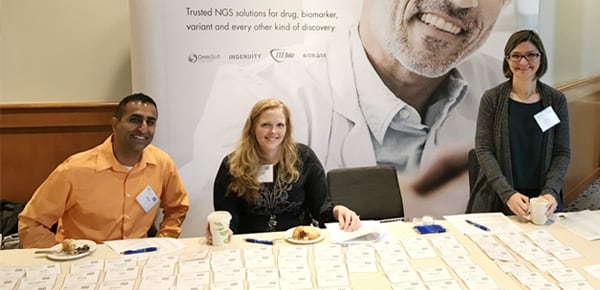


















In case you couldn’t join us in Cambridge, Mass., for the event, we’ve rounded up some highlights from day 1 to give you a sense of how OmicSoft’s products are being used by pharma and biotech researchers in drug discovery every day, and where the future is taking us as we integrate analytic software and curated content with the capabilities of QIAGEN’s product molecular biology offerings. We’d like to thank all the speakers and attendees who have made the meeting a success so far!
The agenda for day 1 included three great customer and collaborator presentations. Principal scientist Xiang (Sean) Yao from Janssen, a division of Johnson & Johnson, has been using OmicSoft tools for 10 years. “I’m a true believer in data integration,” he told attendees, recalling his team’s realization that they didn’t have the capacity internally to fully process and integrate their gene expression data in an efficient and cost-effective manner. He was an early adopter of OmicSoft’s Array Server, Land tools, and cloud computing services for comprehensive target profiling, systematic gene annotation, and data mining. These tools have been key enablers for curating hundreds of public and internal studies in relevant drug discovery areas, such as neuroscience and cardiovascular disease, and allowed his team to supplement public data sources with samples covering underrepresented tissue types in particular. Having access to so many studies gives Yao and his team greater confidence in results, because they can see at a glance whether intriguing results occur consistently in many projects, or are outliers from a single experiment. He said that OmicSoft tools have streamlined data analysis and made it possible to focus internal efforts on late-stage analysis.

From Merck, Associate Principal Scientist Jianchao Yao spoke about using OmicSoft tools for RNA-seq data pipelines. He described a robust workflow that runs thousands of RNA-seq projects, estimating that OmicSoft technology has automated about 80 percent of that process and is used for nearly all of these projects. He also offered advice to anyone dealing with a massive amount of data, such as carefully controlling metadata and establishing a mindset of good data integration.
OmicSoft collaborator Jun Ye, CEO of Sentieon, talked about the lightning-fast algorithms his team has built to accelerate the GATK and related variant calling pipelines used for precision medicine. By re-engineering these pipelines, Sentieon was able to run its version of GATK as much as 50 times faster — a dramatic savings not only in time but also in computational cost. This approach, which also offers consistent results with higher accuracy, is now powering alignment and variant calling for NGS data and enabling large-scale pairwise correlations in OmicSoft. Users can start a job in the OmicSoft interface, automatically process the data with Sentieon, and have results deposited directly into a Land tool for further analysis.
We also had several great talks from people on the QIAGEN Bioinformatics team. OmicSoft founder Jack Liu spoke about the synergies of becoming part of the QIAGEN family and introduced LandPortal, a new web client currently in early access designed to expand OmicSoft tool use to non-bioinformaticians and to facilitate easy sharing of results. He also mentioned recent improvements to existing tools: more than 53,000 samples have been added this year, and rat has been added as a model. Looking ahead, Liu said Array Studio will be harmonized with the new web portal, the Array Suite platform will see a major upgrade, and deeper integration with other QIAGEN tools such as Ingenuity Pathway Analysis® (IPA) will continue to advance.
An early example of that integration is the already powerful connection between OmicSoft and IPA, described in a pair of talks from Joseph Pearson and Jean-Noel Billaud. Using a study of anti-PD1 resistance in melanoma for illustration, they showed how RNA-seq data processing could be performed in Array Studio followed immediately by interpretation in IPA. Once in IPA, users can explore key signaling pathway activities, biological processes, splice variants, and more. For this data, Billaud presented results indicating upregulation of the epithelial-to-mesenchymal transition in melanoma non-responders, suggesting likely tumor progression to metastasis.
Finally, QIAGEN’s Frank Schacherer shared how the OmicSoft acquisition fits into the big-picture view of the company’s long-term strategy for bioinformatics. The addition of OmicSoft’s deep drug discovery informatics capabilities to the portfolio of solutions from Ingenuity Systems, CLC bio, and BIOBASE has allowed QIAGEN to help users get from the very first steps of sample prep all the way to extracting new knowledge from an experiment. That Sample to Insight approach inspired what is now the largest bioinformatics portfolio in the world, helping users publish more than 30,000 papers and adding 3,500 new data elements or findings every day. Schacherer said QIAGEN is committed to the idea that the goal isn’t algorithms, it’s knowledge — and helping users accelerate their journey to new hypotheses.
We’ve still got another day of great talks to go, and will update the blog with more highlights soon!